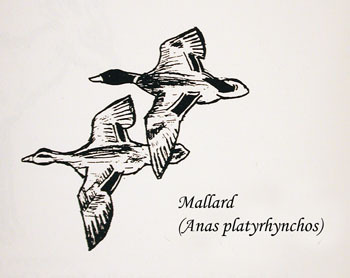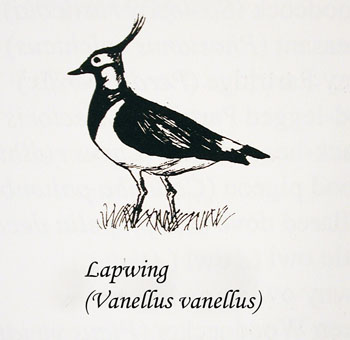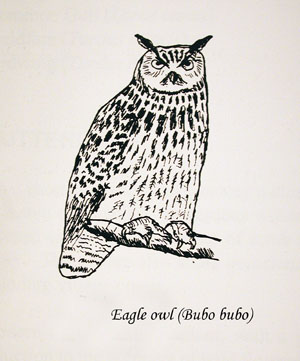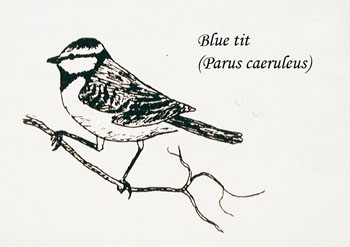| "The Chronicles of a Country Parish" - A village appraisal of Sulgrave published in 1995 |
BIRDS
(Back to Chapter 4 Index)
The birds of the parish are those which one might expect to find in any area of similar kind - there are no extensive ancient woodlands, expanses of water, or marshland, to attract a wider range of species. Undoubtedly changes in land use have affected wildlife; the virtual disappearance of the old-style hay meadows, the removal of some hedges and more intensive cultivation have all reduced the amount of habitat suitable for birds and other life. For example, a lack of 'wild' rough grassland to provide a source of prey is probably the main reason why the barn owl is now rarely seen. Both species of partridge are still present, but uncultivated field-edges are essential for their survival; the earlier harvest of winter-sown wheat is bad news for their young. Elm disease has meant a temporary abundance of nest- and feeding- sites for woodpeckers, all three British species of which have been recorded. On the other hand, the disappearance of tall elms has certainly affected the rooks - there is at present no rookery within the parish, although there is a considerable rook population in the area. Moorhen and mallard breed on some of the small ponds, to which heron pay regular visits. Of birds of prey kestrel and sparrowhawk are frequently seen, the latter now having made a welcome comeback after its decline when the use of DDT and other persistent pesticides was common. Two species which are noticeably more common are the magpie and the collared dove. Sulgrave is fortunate to have annual visits from the cuckoo, whose first arrival in the parish seems to fall always in the second half of April (in the years 1983-1990, its earliest appearance has been on the 15th, its latest on the 25th). Over the same period, comparative dates for three other summer visitors, all of which nest within the village, are: swallow, 12th April - 7th May; house martin, 23rd April - 14th May; swift, 3rd May - 17th May. The course of the disused railway is the best area to see other migrants such as the willow warbler. Regular winter visitors to the parish include large mixed flocks of fieldfare and redwing; less commonly, golden plover, sometimes mingling with lapwing and usually in the Barrow Hill area; and snipe in wetter low lying ground.
considerable rook population in the area. Moorhen and mallard breed on some of the small ponds, to which heron pay regular visits. Of birds of prey kestrel and sparrowhawk are frequently seen, the latter now having made a welcome comeback after its decline when the use of DDT and other persistent pesticides was common. Two species which are noticeably more common are the magpie and the collared dove. Sulgrave is fortunate to have annual visits from the cuckoo, whose first arrival in the parish seems to fall always in the second half of April (in the years 1983-1990, its earliest appearance has been on the 15th, its latest on the 25th). Over the same period, comparative dates for three other summer visitors, all of which nest within the village, are: swallow, 12th April - 7th May; house martin, 23rd April - 14th May; swift, 3rd May - 17th May. The course of the disused railway is the best area to see other migrants such as the willow warbler. Regular winter visitors to the parish include large mixed flocks of fieldfare and redwing; less commonly, golden plover, sometimes mingling with lapwing and usually in the Barrow Hill area; and snipe in wetter low lying ground.

Of course, it is always possible that unusual birds may turn up. Perhaps mention should be made of the most noteworthy of recent such instances; the eagle owl (Bubo bubo) which ws first reported in January 1991. This magnificent bird, a native of mountainous and wooded areas of continental Europe and presumably escaped from a zoo or private collection, remained in the parish for almost two years. At first it frequented the old railway line, presumably living off rabbits and other wild prey, but gradually took to visiting the village itself, and eventually selected the trees on the edge of the Pocket Park as its daytime roosting-place. It soon struck up a friendship with the residents of Towrise, who provided it with titbits and named it "Ollie". However, after Ollie started to make scary night-time swoops on people, it was reluctantly decided that action must be taken. In October 1992, Sulgrave's most exotic inhabitant was captured and sent to a new home in Olney, in Buckinghamshire. It was discovered that Ollie was the shortened from of Olivia, not Oliver. Perhaps the fact that she was now provided with a mate compensated her for her lost liberty.
wooded areas of continental Europe and presumably escaped from a zoo or private collection, remained in the parish for almost two years. At first it frequented the old railway line, presumably living off rabbits and other wild prey, but gradually took to visiting the village itself, and eventually selected the trees on the edge of the Pocket Park as its daytime roosting-place. It soon struck up a friendship with the residents of Towrise, who provided it with titbits and named it "Ollie". However, after Ollie started to make scary night-time swoops on people, it was reluctantly decided that action must be taken. In October 1992, Sulgrave's most exotic inhabitant was captured and sent to a new home in Olney, in Buckinghamshire. It was discovered that Ollie was the shortened from of Olivia, not Oliver. Perhaps the fact that she was now provided with a mate compensated her for her lost liberty.
List of birds recorded as present in or near the parish and to be seen at any time of the year:
Heron (Arda cinerea)
Mallard (Anas platyrhynchos)
Kestrel (Falco tinnunculus)
Sparrowhawk (Accipiter nisus)
Moorhen (Gallinula chloropus)
Lapwing (Vanellus vanellus)
Woodcock (Scolopax rusticola)
Pheasant (Phasianus colchicus)
Grey Partridge (Perdix perdix)
Red-legged Partridge (Alectoris rufa)
Black-headed Gull (Larus ridibundus)
Wood pigeon (Columba palumbus)
Collared dove (Streptopelia decaocto)
Little owl (Athene noctua)
Tawny owl (Strix aluco)
Green Woodpecker (Picus viridis)
Great Spotted Woodpecker (Dendrocopus major)
Lesser Spotted Woodpecker (Dendrocupus minor)
Skylark (Alauda arvensis)
Carrion Crow (Corvus corone)
Rook (Corvus frugilegus)
Magpie (Pica pica)
Jay (Garrulus glandarius)
Great Tit (Parus major)
Blue Tit (Parus caeruleus)
Coal Tit (Parus ater)
Long-tailed Tit (Aegithalos caudatus)
Tree Creeper (Certhia familiaris)
Wren (Troglodytes troglodytes)
Mistle Thrush (Turdus viscivorus)
Song Thrush (Turdus philomelos)
Blackbird (Turdus merula)
Robin (Erithacus rubecula)
Goldcrest (Regulus regulus)
Dunnock (Prenella modularis)
Pied Wagtail (Motacilla alba)
Starling (Sturnus vulgaris)
Greenfinch (Carduelis chloris)
Goldfinch (Caruelis carduelis)
Bullfinch (Pyrrhula pyrrhula)
Chaffinch (Fingilla coelebs)
Linnet (Acanthis cannabina)
Yellowhammer (Emberiza citrinella)
House Sparrow (Passer domesticus)
Tree Sparrow (Passer montanus)

List of birds which visit the parish during the summer (regular breeders):
Cuckoo (Cuculus canorus)
Swift (Apus apus)
House Martin (Delichon urbica)
Swallow (Hirundo rustica)
Willow Warbler (Phylloscopus trochilus)
Chiffchaff (Sylvia communis)
Lesser Whitethroat (Sylvia curruca)
Spotted Flycatcher (Muscicapa striata)
List of birds which visit the parish during the winter:
Golden Plover (Charadrius apricarius)
Snipe (Gallinago gallinago)
Herring Gull (Larus argentatus)
Common Gull (Larus canus)
Fieldfare (Turdus pilaris)
Redwing (Turdus musicus)
TOP
 considerable rook population in the area. Moorhen and mallard breed on some of the small ponds, to which heron pay regular visits. Of birds of prey kestrel and sparrowhawk are frequently seen, the latter now having made a welcome comeback after its decline when the use of DDT and other persistent pesticides was common. Two species which are noticeably more common are the magpie and the collared dove. Sulgrave is fortunate to have annual visits from the cuckoo, whose first arrival in the parish seems to fall always in the second half of April (in the years 1983-1990, its earliest appearance has been on the 15th, its latest on the 25th). Over the same period, comparative dates for three other summer visitors, all of which nest within the village, are: swallow, 12th April - 7th May; house martin, 23rd April - 14th May; swift, 3rd May - 17th May. The course of the disused railway is the best area to see other migrants such as the willow warbler. Regular winter visitors to the parish include large mixed flocks of fieldfare and redwing; less commonly, golden plover, sometimes mingling with lapwing and usually in the Barrow Hill area; and snipe in wetter low lying ground.
considerable rook population in the area. Moorhen and mallard breed on some of the small ponds, to which heron pay regular visits. Of birds of prey kestrel and sparrowhawk are frequently seen, the latter now having made a welcome comeback after its decline when the use of DDT and other persistent pesticides was common. Two species which are noticeably more common are the magpie and the collared dove. Sulgrave is fortunate to have annual visits from the cuckoo, whose first arrival in the parish seems to fall always in the second half of April (in the years 1983-1990, its earliest appearance has been on the 15th, its latest on the 25th). Over the same period, comparative dates for three other summer visitors, all of which nest within the village, are: swallow, 12th April - 7th May; house martin, 23rd April - 14th May; swift, 3rd May - 17th May. The course of the disused railway is the best area to see other migrants such as the willow warbler. Regular winter visitors to the parish include large mixed flocks of fieldfare and redwing; less commonly, golden plover, sometimes mingling with lapwing and usually in the Barrow Hill area; and snipe in wetter low lying ground.
 wooded areas of continental Europe and presumably escaped from a zoo or private collection, remained in the parish for almost two years. At first it frequented the old railway line, presumably living off rabbits and other wild prey, but gradually took to visiting the village itself, and eventually selected the trees on the edge of the Pocket Park as its daytime roosting-place. It soon struck up a friendship with the residents of Towrise, who provided it with titbits and named it "Ollie". However, after Ollie started to make scary night-time swoops on people, it was reluctantly decided that action must be taken. In October 1992, Sulgrave's most exotic inhabitant was captured and sent to a new home in Olney, in Buckinghamshire. It was discovered that Ollie was the shortened from of Olivia, not Oliver. Perhaps the fact that she was now provided with a mate compensated her for her lost liberty.
wooded areas of continental Europe and presumably escaped from a zoo or private collection, remained in the parish for almost two years. At first it frequented the old railway line, presumably living off rabbits and other wild prey, but gradually took to visiting the village itself, and eventually selected the trees on the edge of the Pocket Park as its daytime roosting-place. It soon struck up a friendship with the residents of Towrise, who provided it with titbits and named it "Ollie". However, after Ollie started to make scary night-time swoops on people, it was reluctantly decided that action must be taken. In October 1992, Sulgrave's most exotic inhabitant was captured and sent to a new home in Olney, in Buckinghamshire. It was discovered that Ollie was the shortened from of Olivia, not Oliver. Perhaps the fact that she was now provided with a mate compensated her for her lost liberty.